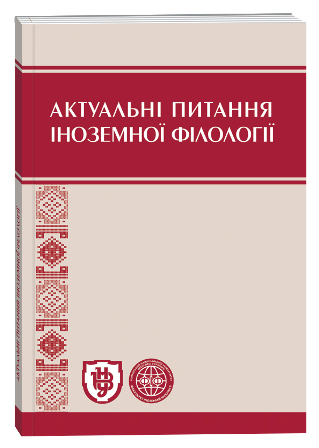ARTISTIC MODELING OF A SCHIZOPHRENIC DISCOURSE (A COGNITIVE ASPECT)
Keywords:
Theory of Mind, source-monitoring, schizophrenic discourse, reconceptualizationAbstract
The article concentrates on the application and empirical verification of the Theory of Mind (Mind-Reading), the term used by cognitive psychologists to describe our ability to explain people’s behaviour in terms of their thoughts, feelings, beliefs and desires. The research is predicated on the ideas of L. Zunshine, D. Herman, M. Fludernik, I. Bockting. The content of the article reflects the results of the analysis of an artistically (aesthetically) modeled schizophrenic discourse (henceforth SD) in William Faulkner’s second section (Quentin Compson’s monologue) of “The Sound and the Fury”. The SD is a type of a discourse of the character’s altered state of consciousness when his or her systems of perception and cognition function following an autonomous pattern under the extreme circumstances (O. Selivanova). The first part of the article contains a few comments on the underpinnings of a cognitive approach to a literary narrative. The conclusion is made that cognitively oriented investigation of a piece of fiction provides a reconceptualisation of the basic parameters of a narrative, such as focalization, narrator, character, spatio-temporal coordinates, implied author. The second part of the article is a proof of the validity of the following hypothesis: a SD requires an ongoing, non-stop interaction between the “actual possible world” (M. L. Ryan) of the novel and the reader. The former is characterized by modulated snippets of Quentin’s thoughts, allusions, and memories, sometimes reminding us of Molly Bloom’s monologue in J.Joyce’s “Ulysses”. The latter has his or her own cognitive processing potential and cognitive adaptation “mechanism”. The efficiency of this “game” between the SD and the reader depends on how capable he or she is to identify and monitor (track) the sources of utterances, thoughts and memories that surface in Quentin’s consciousness. The examples from the text of Faulkner’s novel illustrate the procedure of source tracking in Quentin’s SD and provide evidence of the destruction of Quentin’s source-tracking ability. The final part of the article points to prospects of further cognitive-narratological study of anomalous narratives.
References
Vaclavik, Paul; Bivin, Janet; Dzhekson, Don. 2002. Pragmatika chelovecheskih komunikacij: Izuchenie paternov, patologij i paradoksov vzaimodejstvija. Aprel-press, Izd-vo Eksmo press.
Zasjekin, Serhii. 2019. Psyholingvistychni universalii perekladu hudozhnogo tekstu: monografiia. Luck: VNU im. Lesi Ukrainky.
Korotkova, Liudmyla. 2001. “Semantyko-kognityvnyj ta funkcionalnyi aspekty tekstovyh anomalii u suchasnii anglomovnii hudozhniiprozi”. PhD diss., Kyiv.
Levin, Yurii. 1998. Izbrannye trudy. Pojetika. Semiotika. M.: Jazyki russkoj kultury.
Marina, Olena. 2015. Semiotyka paradoksalnosti u kognityvno-komunikatyvnomu vysvitlenni (na materiali suchasnogo anglomovnogo poetychnogo dyskursu): monografiia. Herson: Ajlant.
Prysjazhnjuk, Liudmyla. 2010. “Poetyka zminenyh staniv svidomosti: lingvopsyhologichnyi aspect”. Visnyk Zhytomyrskogo derzhavnogo universytetu. Seria: Filologichni nauky.
Rudnev, Vadym. 2000. Proch ot realnosti: Issledovania po filosofii teksta. M.: Agraf.
Rudnev, Vadym. 2000. Enciklopedicheskij slovar kultury 20 veka. M.: Agraf.
Selivanova, Olena. 2006. Suchasna lingvistyka: Terminologichna encyklopediia. Poltava: Dovkillia.
Troshyna, N. 1983. “Semioticheskii aspekt stilisticheskoi struktury poeticheskogo teksta (obzor) ”. Semiotika. Kommunikaciia. Stil. Sb.Obzorov. M.: INION ANSSSR.
Atkinson, Richard; Smith, Edward; Bem, Daryl. 1990. Introduction to Psychology. Orlando, Florida: Harcourt Brace Jovanovich College Publs.
Bockting, Ineke. 1990. The Impossible World the “Schizophrenic” Faulkner’s Quentin Compson. Style.
Faulkner, William. 1992. The Sound and the Fury. N.Y.: The Modern Library.
Fludernik, Monika. 2003. “Natural Narratology and Cognitive Parameters”. Narrative Theory and the Cognitive Sciences [ed. D. Herman]. Stanford, California: CSLI Publications.
Herman, David. 2003. “Introduction”. Narrative Theory and Cognitive Sciences. Stanford: California.
Phelan, James. 2001. “Why Narrators Can Be Focalizers – and Why It Matters”. New Perspectives on Narrative Perspectives. Albany: State Univ. of NY Press.
Ryan, M.-L. 1991. Possible Worlds, Artificial Intelligence, and Narrative Theory. Bloomington and Indianapolis: Indiana UP.
Tart Ch.T. Putting the Pieces Together: a Conceptual Framework for Understanding Discretе States of Consciousness. N.Y. The Free Press. A Division of Macmillan Publ. Co.; L.: Collier Macmillan Publishers.
Tsur, Reuven. 2008. Toward a Theory of Cognitive Poetics. Brighton. Portland: Sussex Academic Press.
Zunshine, Lisa. 2006. Why Do We Read Fiction: Theory оf Mind and the Novel. Columbus; The Ohio State University Press.







